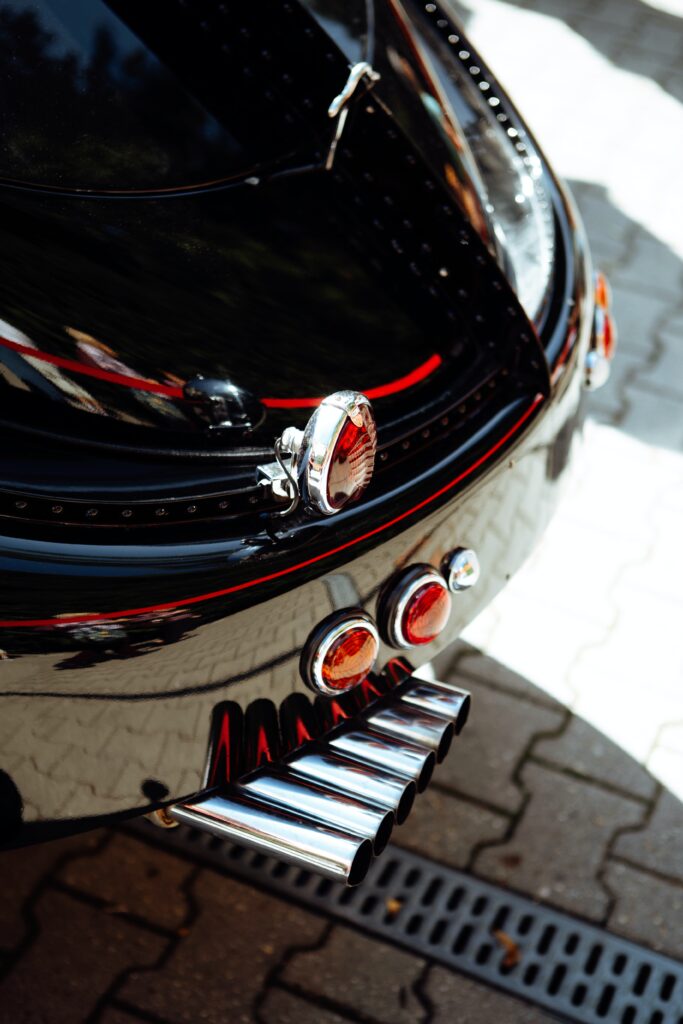Intrigued by the inner workings of your vehicle’s exhaust system? Look no further! This article explores the fascinating world of exhaust silencers, shedding light on their role and functionality. From reducing noise pollution to maintaining optimal engine performance, you’ll discover how these silent heroes muffle the roar of your engine without compromising its power. So buckle up and get ready to uncover the mysteries behind the magic of exhaust silencers!

Understanding the Basics of an Exhaust Silencer
Definition of an exhaust silencer
An exhaust silencer, also commonly referred to as a muffler, is a device that is installed in the exhaust system of a vehicle to reduce the noise produced by the engine. It is designed to absorb and dissipate the sound waves created by the combustion process, resulting in a quieter operation.
Purpose of an exhaust silencer
The primary purpose of an exhaust silencer is to reduce the noise generated by the vehicle’s engine. This is achieved by using a combination of acoustic materials and internal components which manipulate the sound waves, converting them into heat energy and reducing their intensity. In addition to reducing noise pollution, exhaust silencers also play important roles in maintaining engine performance and controlling emissions.
The Basic Construction of an Exhaust Silencer
Materials used
Exhaust silencers are typically made from a combination of metal, such as steel or aluminum, and acoustic materials. The metal components provide the necessary strength and durability, while the acoustic materials, such as fiberglass or sound-absorbing foam, help to minimize and absorb the noise generated by the engine.
Components of an exhaust silencer
An exhaust silencer consists of several key components that work together to achieve noise reduction. These components include an inlet pipe, internal baffles, perforated tubes, and an outlet pipe. The inlet pipe is responsible for directing the exhaust gases into the silencer, while the internal baffles and perforated tubes create a series of chambers that allow the sound waves to dissipate and be absorbed. Lastly, the outlet pipe allows the treated exhaust gases to exit the silencer and continue on their way.
How these components work together
The exhaust gases enter the exhaust silencer through the inlet pipe, which directs them into the internal chambers. As the gases travel through the chambers, they encounter the internal baffles and perforated tubes. These components serve to break up and redirect the sound waves, causing them to collide and cancel each other out. This collision and cancellation process effectively reduces the intensity of the sound waves. The acoustic materials within the silencer also help to absorb the sound waves, further reducing the noise produced by the engine. Finally, the treated exhaust gases exit the silencer through the outlet pipe, resulting in a quieter operation.
The Sound Wave Principle
Understanding sound waves
Sound waves are a form of energy that travels through a medium, such as air or metal. They are characterized by their frequency, which determines the pitch or tone of the sound, and their amplitude, which determines the volume or intensity of the sound. In the context of an exhaust silencer, sound waves are generated by the combustion process within the engine and are transmitted through the exhaust gases.
How exhaust silencer uses sound wave principle to function
An exhaust silencer utilizes the principles of sound waves to reduce the noise produced by the engine. By creating a series of chambers, internal baffles, and perforated tubes, the silencer manipulates the sound waves and causes them to collide and cancel each other out. This constructive and destructive interference reduces the overall intensity of the sound waves, resulting in a quieter operation. Additionally, the acoustic materials within the silencer help to absorb and dissipate the sound waves, further contributing to noise reduction.
The Role of the Muffler in an Exhaust Silencer
Function of the muffler
The Muffler is a crucial component of an exhaust silencer and plays a significant role in noise reduction. It is responsible for creating an environment within the silencer that allows the sound waves to be manipulated effectively. Additionally, the muffler helps to improve engine performance by reducing back pressure and controlling the flow of exhaust gases.
Construction and design of the muffler
Mufflers are typically constructed using a combination of metal components and acoustic materials. The metal casing provides structural strength and durability, while the acoustic materials, such as fiberglass or sound-absorbing foam, line the internal chambers of the muffler and help to absorb and dissipate the sound waves. The design of the muffler is carefully engineered to create the ideal conditions for noise reduction, taking into account factors such as flow dynamics and acoustic resonance.
Effect of the muffler on the exhaust gases
In addition to its role in noise reduction, the muffler also has an impact on the flow and performance of the exhaust gases. The internal design of the muffler helps to minimize back pressure, which is the resistance that the exhaust gases encounter as they exit the engine. By reducing back pressure, the muffler allows for smoother and more efficient expulsion of the exhaust gases, which can improve engine performance and fuel efficiency.

The Concept of Back Pressure in Exhaust Silencers
Understanding back pressure
Back pressure refers to the resistance that the exhaust gases encounter as they exit the engine and travel through the exhaust system. It is created by various factors, including the design of the exhaust system, the presence of components such as catalytic converters, and the overall flow dynamics. Too much back pressure can have a negative impact on engine performance, while too little can result in increased noise and emissions.
The role of back pressure in an exhaust silencer
In an exhaust silencer, back pressure is managed and controlled to optimize engine performance and noise reduction. The internal design of the silencer, including the baffles and perforated tubes, is carefully engineered to create a balance between back pressure and noise reduction. By providing the necessary resistance to the exhaust gases, the silencer helps to regulate the flow and maintain an optimal level of back pressure.
How an exhaust silencer manages back pressure
An exhaust silencer manages back pressure by using a combination of design and internal components. The baffles and perforated tubes within the silencer create a series of chambers that guide the flow of the exhaust gases and control the resistance encountered. Additionally, the size and shape of the internal components are carefully calculated to ensure the appropriate level of back pressure for the specific vehicle and engine configuration.
The Importance of Exhaust Silencer Maintenance
What happens when an exhaust silencer doesn’t work properly
When an exhaust silencer fails to function properly, several issues can arise. Firstly, the noise produced by the engine will be significantly louder, potentially causing discomfort to the driver and passengers and leading to noise pollution. Secondly, the increased noise can also indicate underlying problems with the engine or exhaust system, which may require costly repairs if not addressed promptly. Lastly, a malfunctioning exhaust silencer can negatively impact engine performance, fuel efficiency, and the overall functionality of the vehicle.
Signs of a failing exhaust silencer
There are several signs that indicate a Failing exhaust silencer. One of the most noticeable signs is an increase in the noise level of the engine. If the exhaust silencer is not effectively reducing the sound waves, the engine will produce a louder and more pronounced noise. Additionally, a failing exhaust silencer may exhibit signs of physical damage, such as rust or corrosion. Poor engine performance, decreased fuel efficiency, and unusual vibrations can also be indicative of a malfunctioning exhaust silencer.
How to maintain an exhaust silencer
To ensure the optimal functioning and longevity of an exhaust silencer, regular maintenance is necessary. This includes periodic inspections for signs of physical damage or deterioration, such as rust or holes, and addressing any issues promptly. It is also important to keep the exhaust system clean and free from debris, as the buildup of dirt and debris can hinder the performance of the silencer. Lastly, following the manufacturer’s recommended maintenance schedule, including regular check-ups and servicing, will help to prevent and address any potential problems with the exhaust silencer.

The Role of an Exhaust Silencer in Emission Control
Connection between exhaust silencer and vehicle emissions
Exhaust silencers play a significant role in controlling and reducing harmful emissions from vehicles. The combustion process within the engine produces a variety of pollutants, including carbon monoxide, nitrogen oxides, and particulate matter. The exhaust silencer, along with other emission control components such as catalytic converters, helps to minimize the release of these pollutants into the environment.
How an exhaust silencer helps control harmful emissions
An exhaust silencer helps control harmful emissions by acting as a part of the overall emission control system of a vehicle. The internal design and components of the silencer work in conjunction with other emission control devices to reduce the levels of pollutants in the exhaust gases. The acoustic materials within the silencer not only absorb and dissipate sound waves but also help to trap and break down some of the harmful particles and gases, thereby reducing their emission into the atmosphere.
The Impact of Exhaust Silencer on Vehicle Performance
Impact on engine performance
An exhaust silencer can have a significant impact on the overall performance of a vehicle. By optimizing the flow of exhaust gases and managing back pressure, the silencer allows the engine to operate more efficiently. This can result in improved horsepower, torque, and throttle response. Additionally, a properly functioning exhaust silencer helps to maintain the appropriate exhaust gas temperatures, which can further enhance engine performance and longevity.
Impact on fuel efficiency
Fuel efficiency is another aspect of vehicle performance that can be influenced by the exhaust silencer. By reducing back pressure and allowing for smoother expulsion of exhaust gases, the silencer helps to improve the efficiency of the engine. This can result in reduced fuel consumption and increased mileage, ultimately saving the driver money on fuel expenses.
Impact on overall vehicle functionality
The functionality of a vehicle is closely tied to the performance of its components, including the exhaust silencer. A properly functioning exhaust silencer contributes to a quieter and more comfortable driving experience by reducing engine noise. It also helps to maintain the health and longevity of the engine by optimizing exhaust gas flow and minimizing back pressure. In addition, the emission control capabilities of the exhaust silencer ensure that the vehicle meets environmental regulations and contributes to cleaner air quality. Overall, the exhaust silencer plays a vital role in ensuring smooth and efficient functioning of the vehicle as a whole.
In conclusion, understanding the basics of an exhaust silencer is essential for vehicle owners and enthusiasts. By comprehending its construction, the principles of sound waves, the role of the muffler, the management of back pressure, the importance of maintenance, its impact on emission control, and its influence on vehicle performance, one can appreciate the significant role an exhaust silencer plays in a vehicle’s operation. Whether it’s reducing noise pollution, improving engine performance, enhancing fuel efficiency, or contributing to a cleaner environment, the exhaust silencer is an essential component that warrants attention and proper maintenance.
